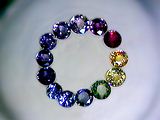![]()
Name:
Sapphire (Corundum)

Chem:
Al2O3
-
Aluminum Oxide
Crystal:
Hexagonal (sometimes tapering crystals)
Color:
Sapphires may be all colors except red, if red it is called ruby. Common colors, clear, blue, pink, green, yellow, violet.
Refrac. Index:
1.76 - 1.77
Birefraction:
0.008
Hardness:
9.0
Spec. Grav.:
3.9 - 4.1
Fracture:
uneven
Cleavage:
none
Environment:
it occurs in nepheline syenite pegmatites, contact metamorphics, and hornfels
Association:
albite, andalusite, cordierite, muscovite, oligoclase
Locals:
| Mon., N.C., USA | Canada | Thailand | Australia |
Misc:
The mineral name Corundum comes from Sanskrit "kuruntam", "red-stone or ruby". The name Ruby comes from the Latin "ruber", meaning "red". The name Sapphire comes from the Sanskrit "sanipriya", which means "dear to the planet Saturn". Insoluble in acids. Poor qualities are used as an abrasive, and it is made synthetically.
Gem info:
In general all colors of corundum that are not RED are called sapphire. This is done so that there are no poor grades given to light pink stone. It is not a poor quality ruby, it is a pink sapphire. The most desired color is called "corn-flower blue", and any traces of gray detract from the value. There is one special variety , an orange-pink stone (very rare) called Padparadscha (which is a Sinalese word for "lotus blossom".
Sapphires fall behind diamond, emerald, and ruby is price, but not much. The non-blue stones are worth substantially less. Of the other colors the special Padparadscha and pink stones are the most expensive.
![]()
ring of stones
![]()
yellow stones